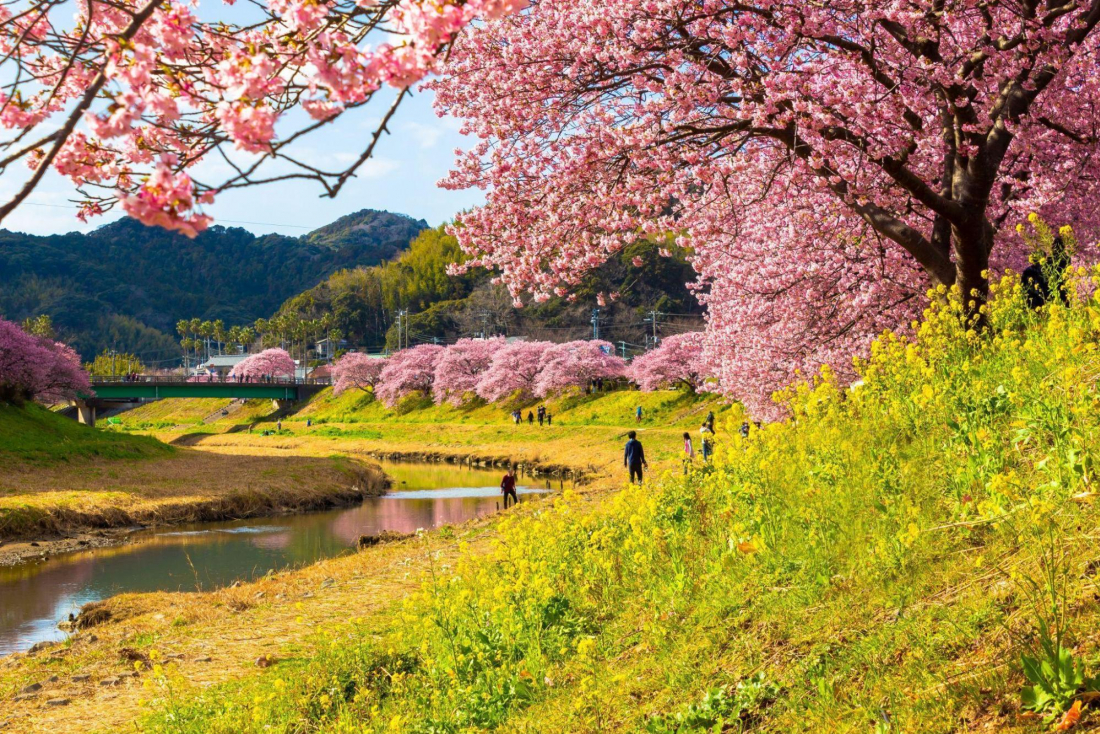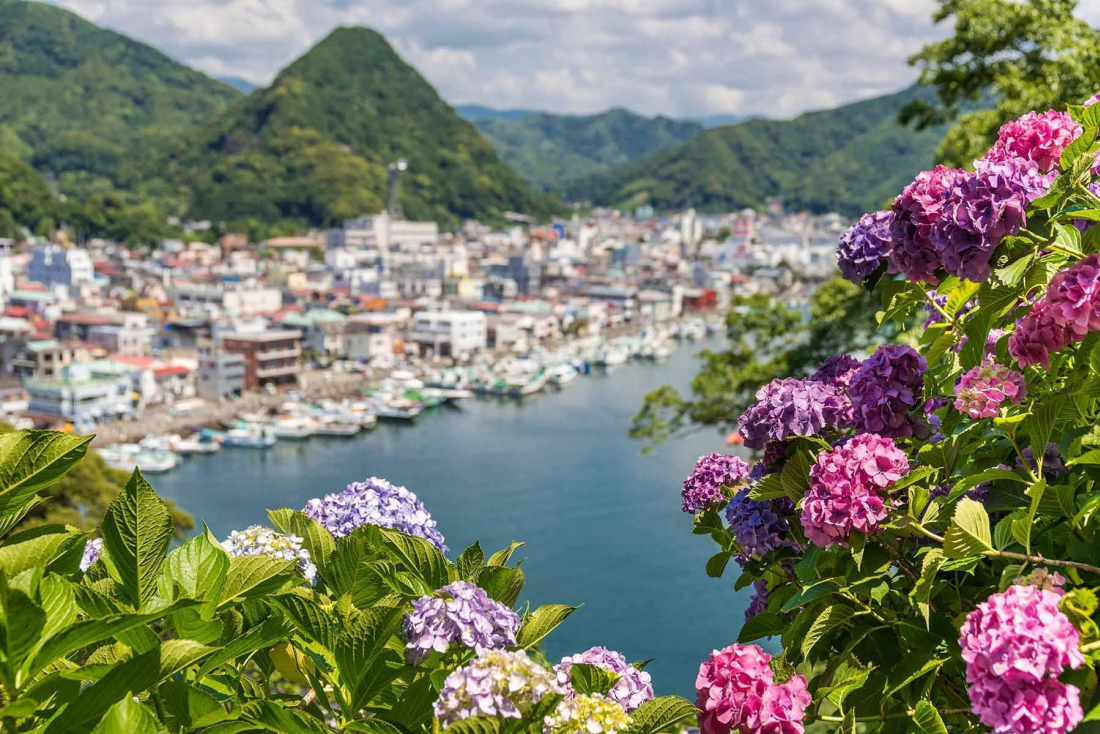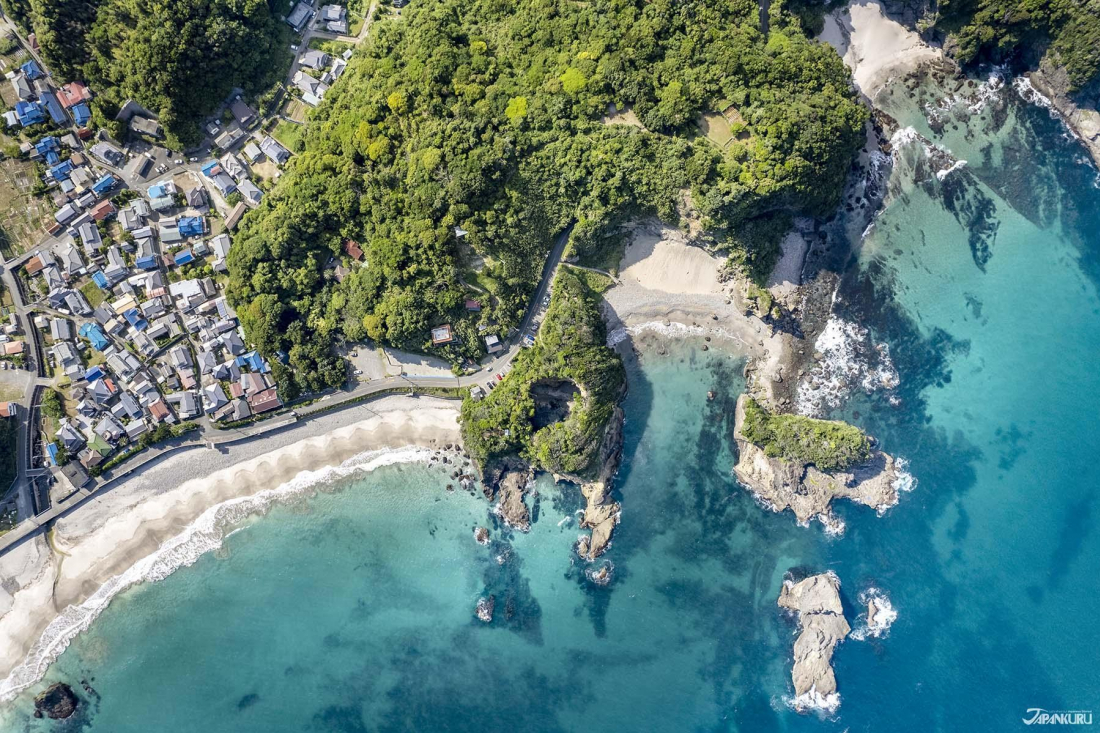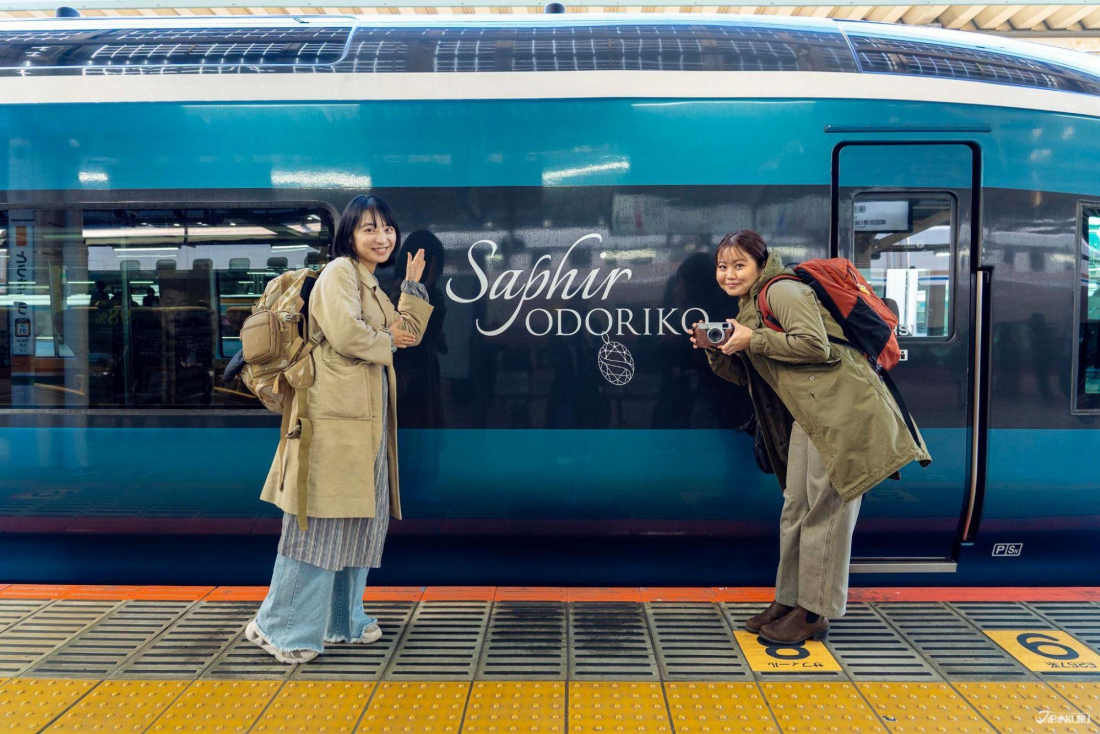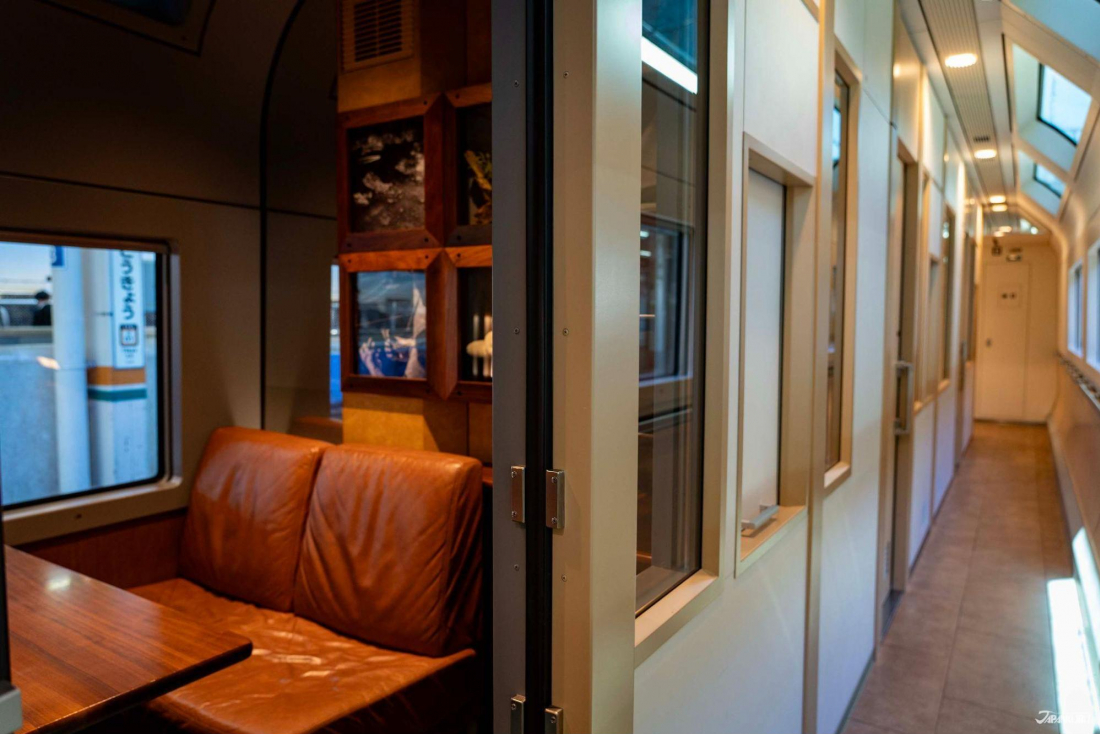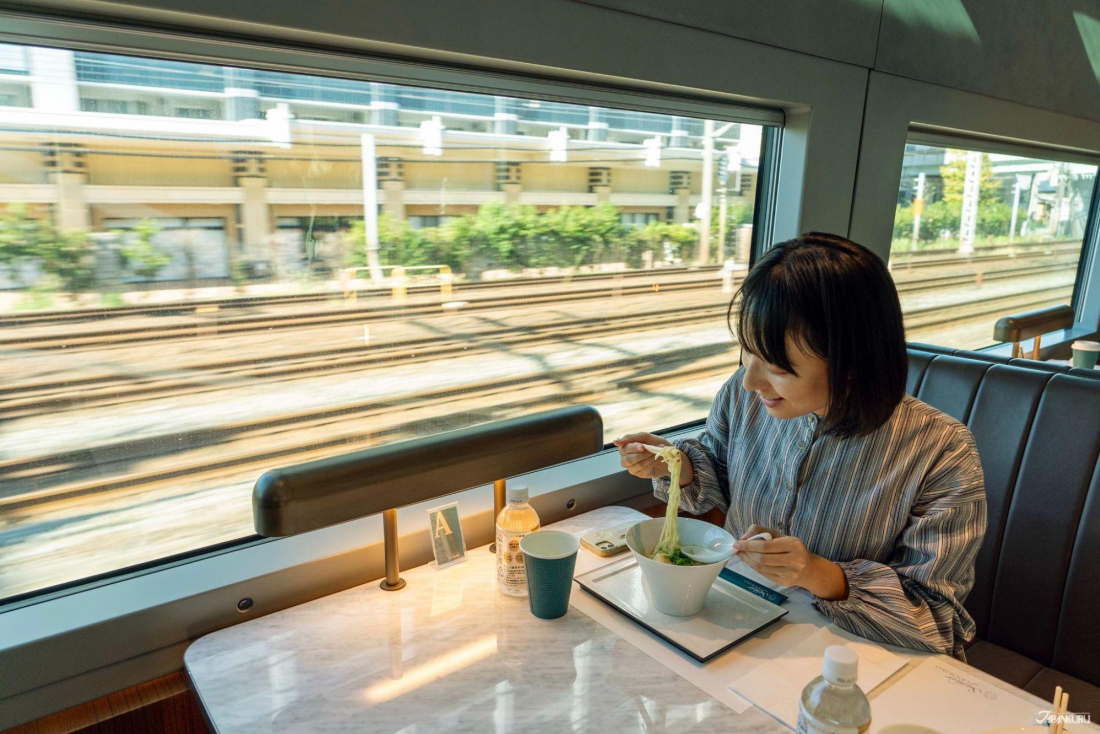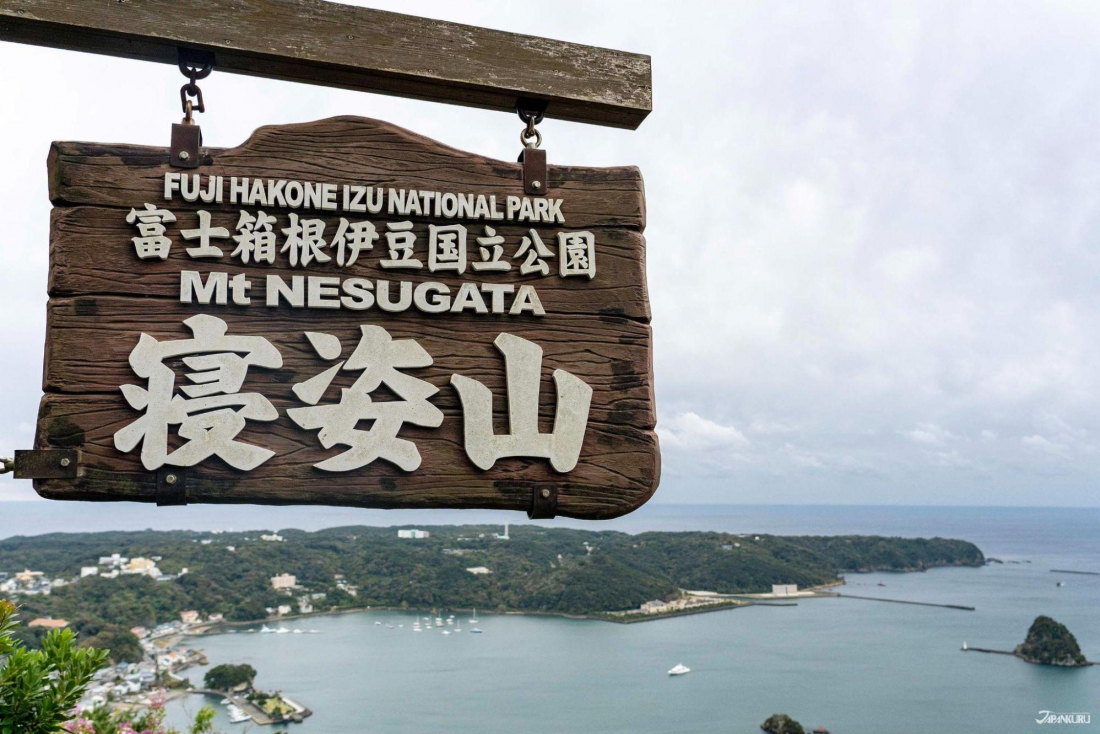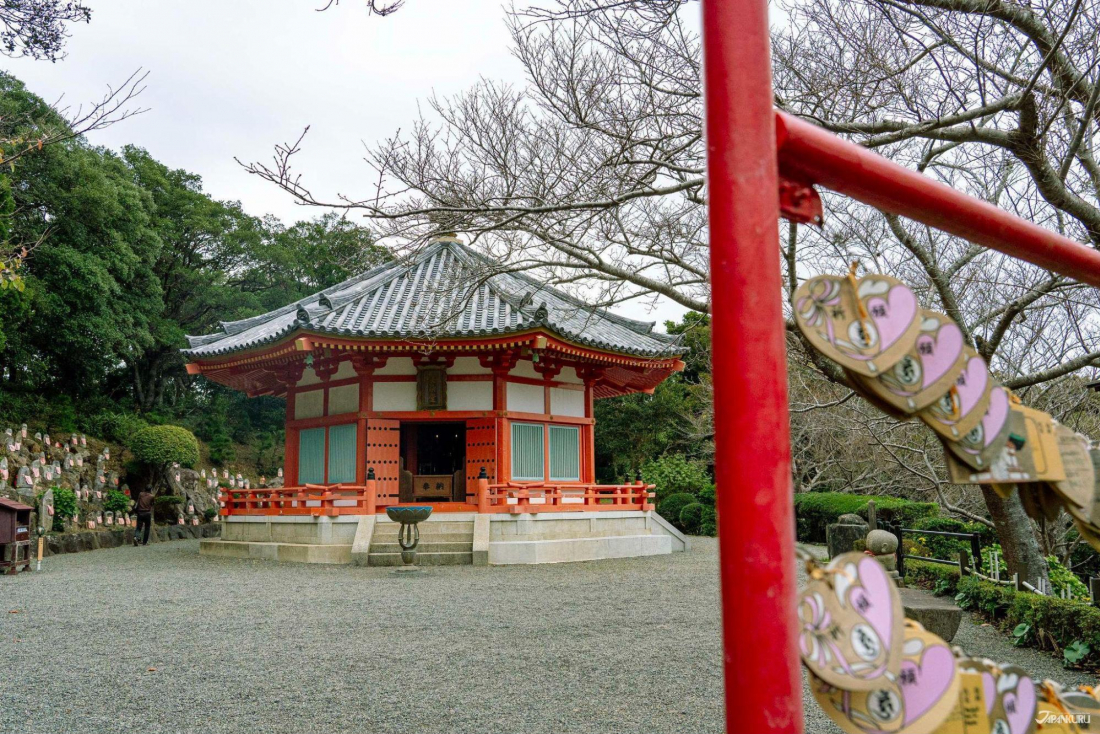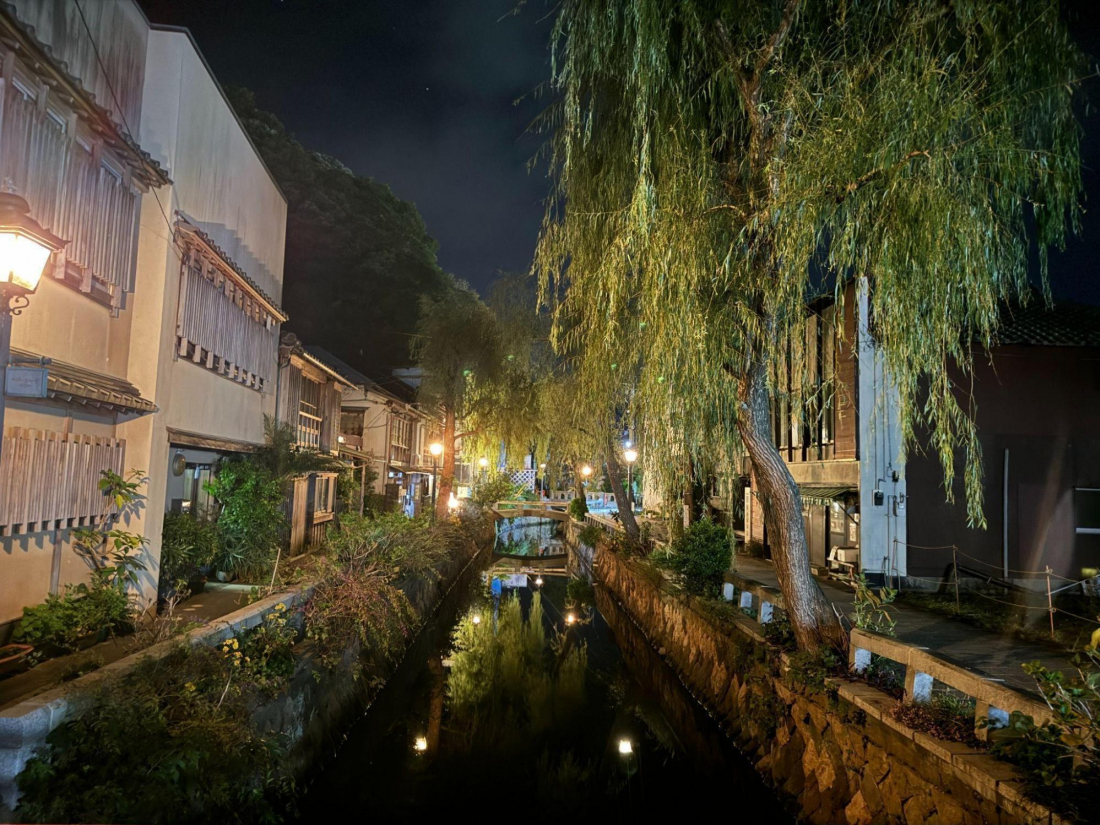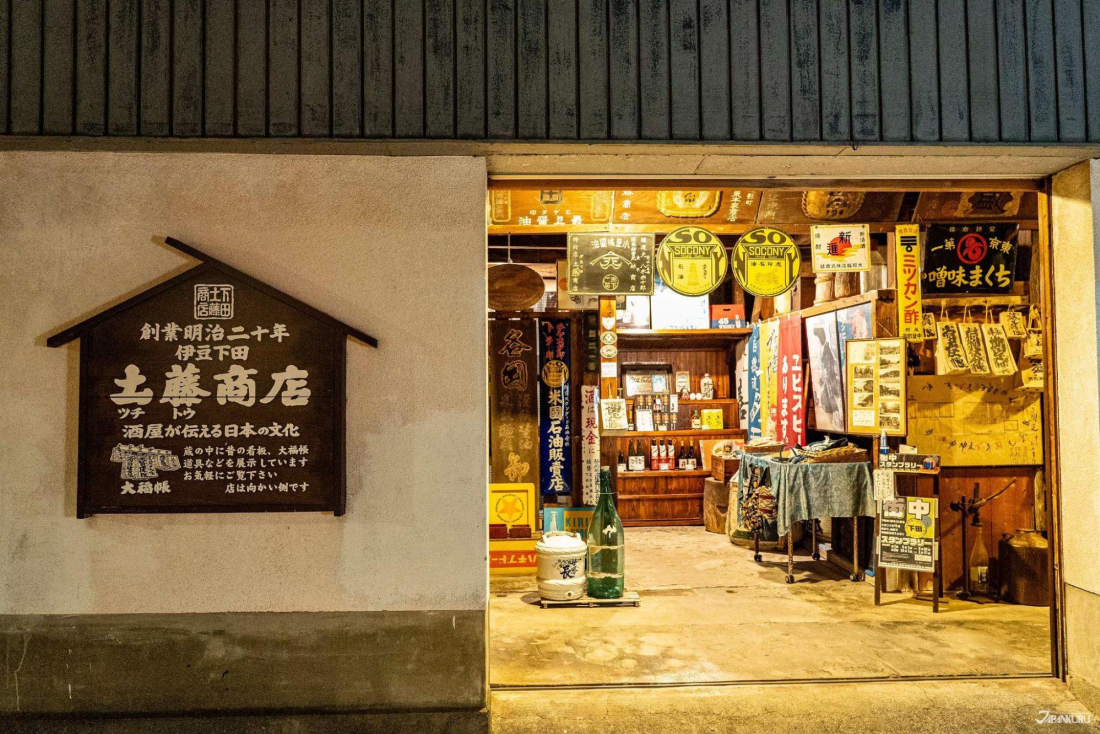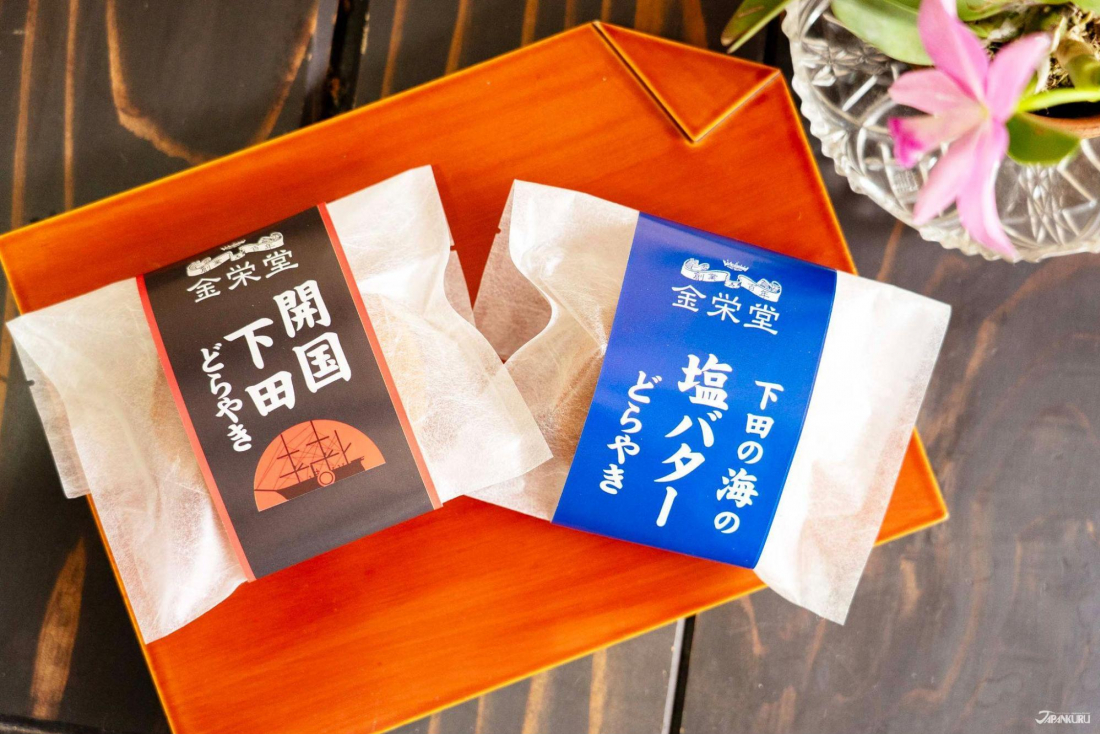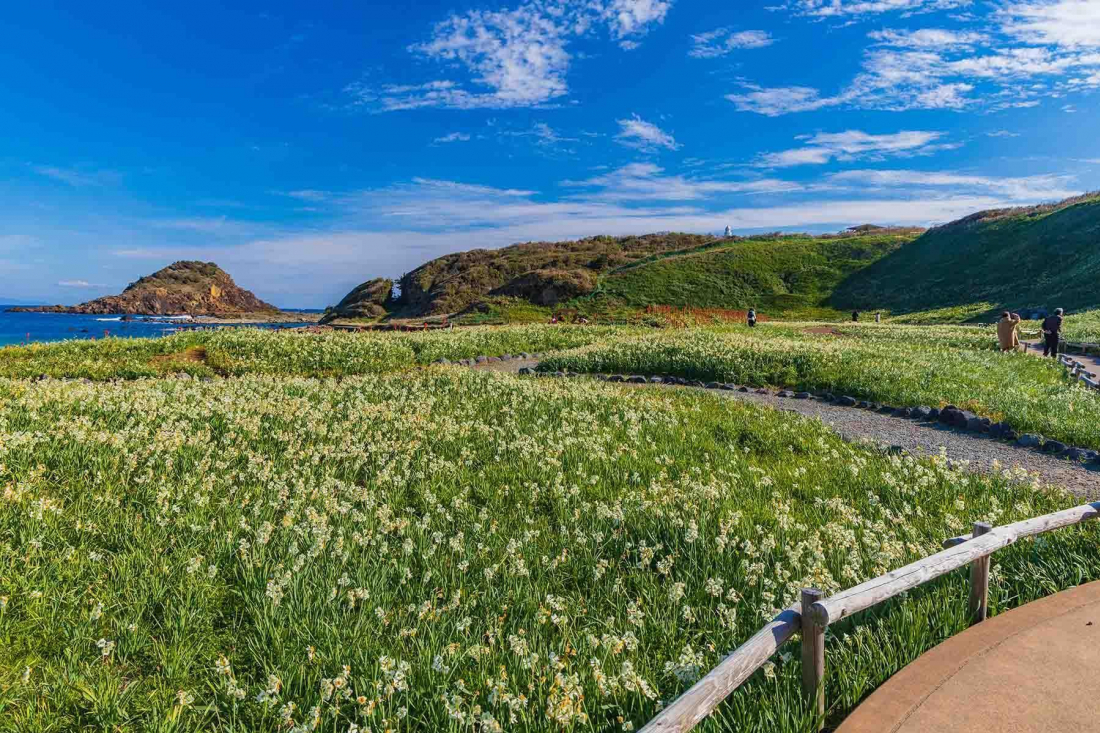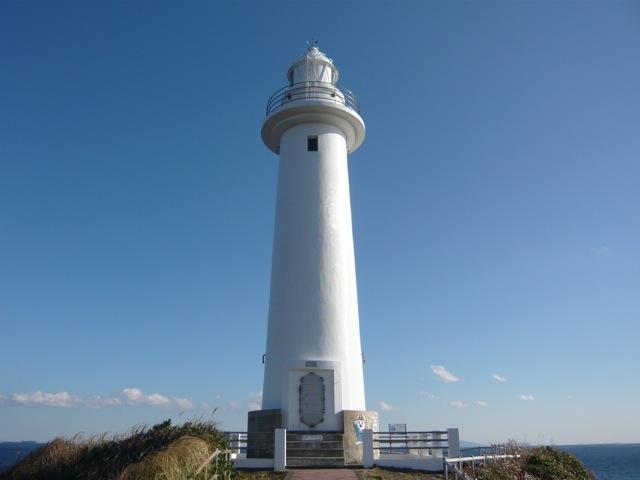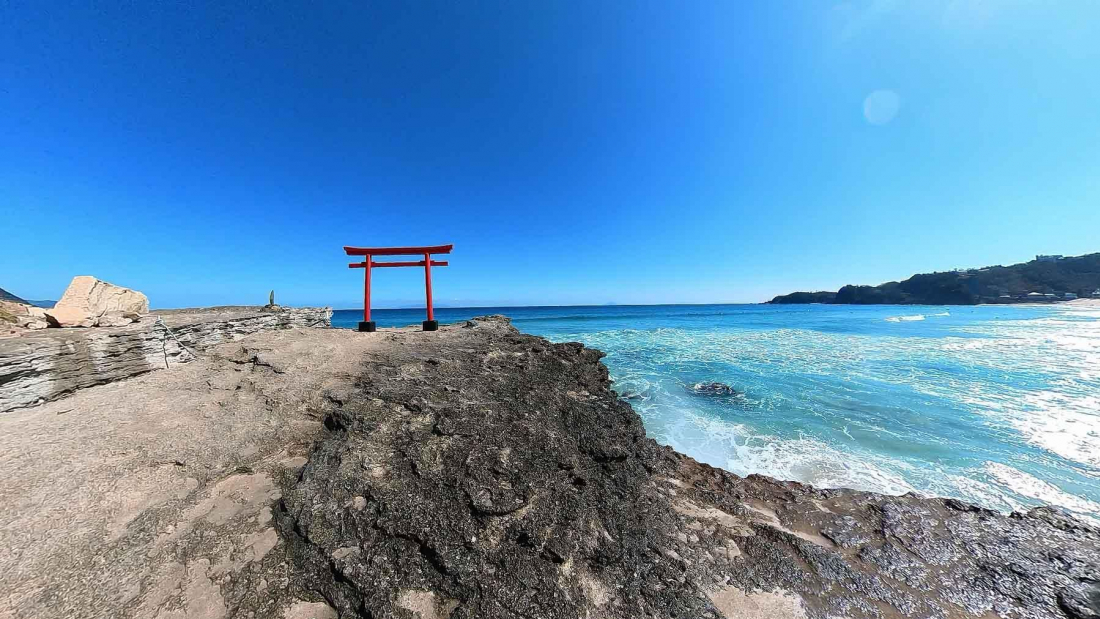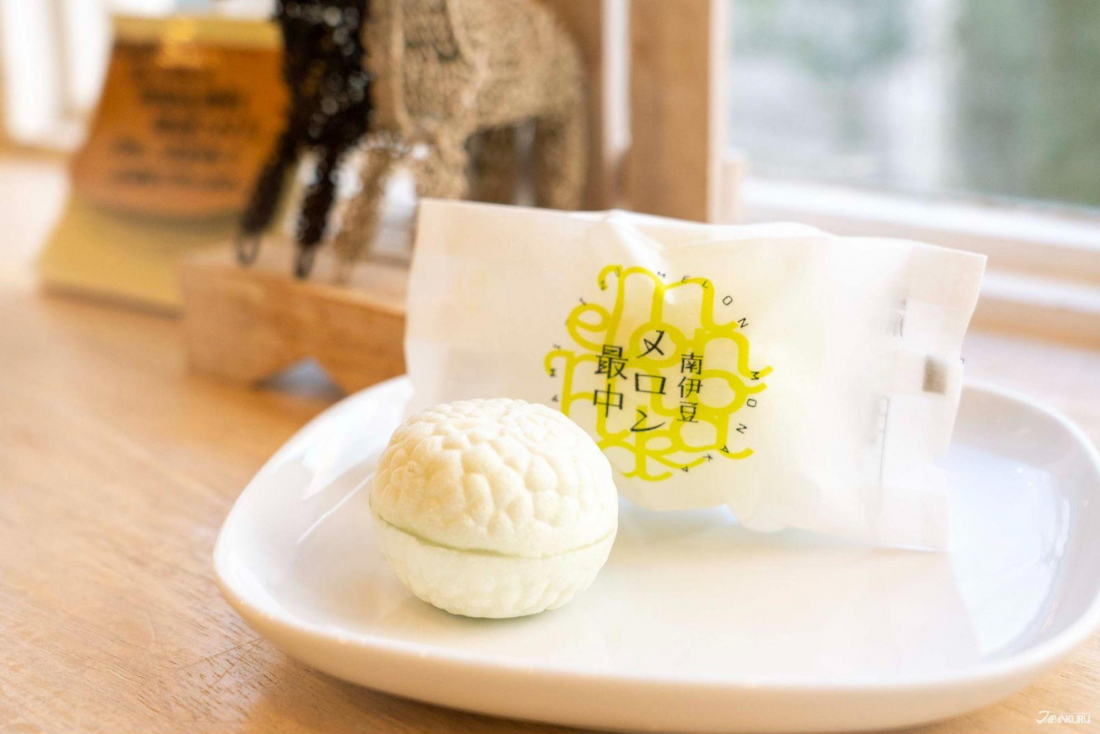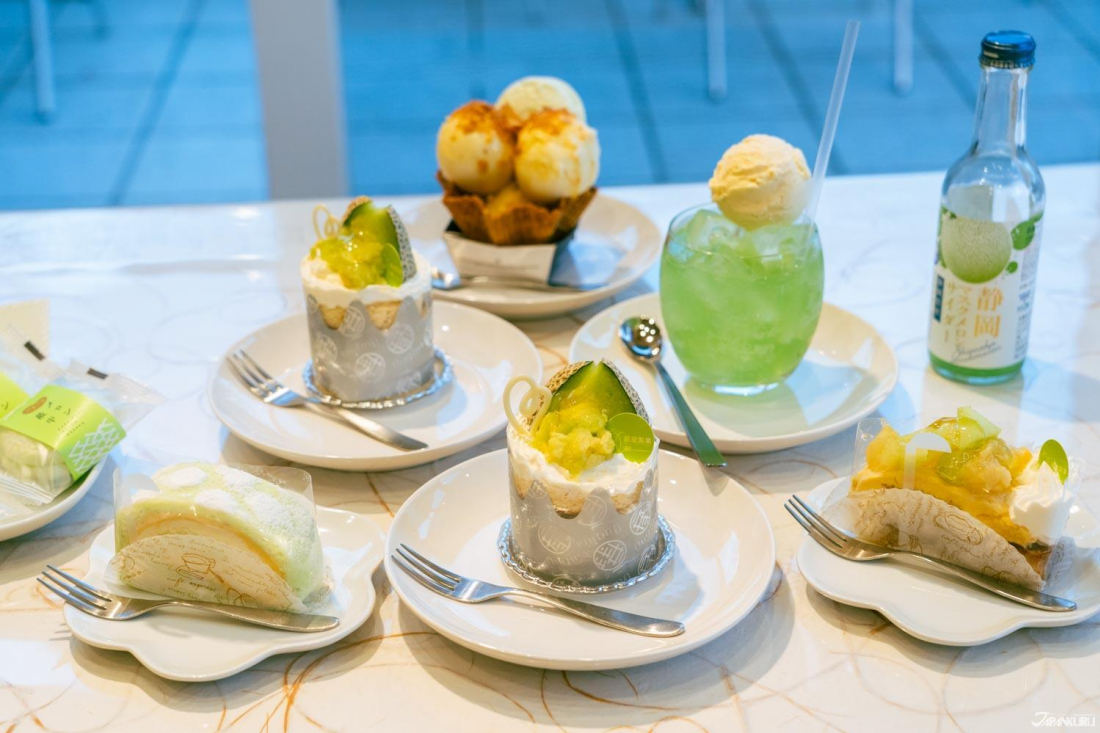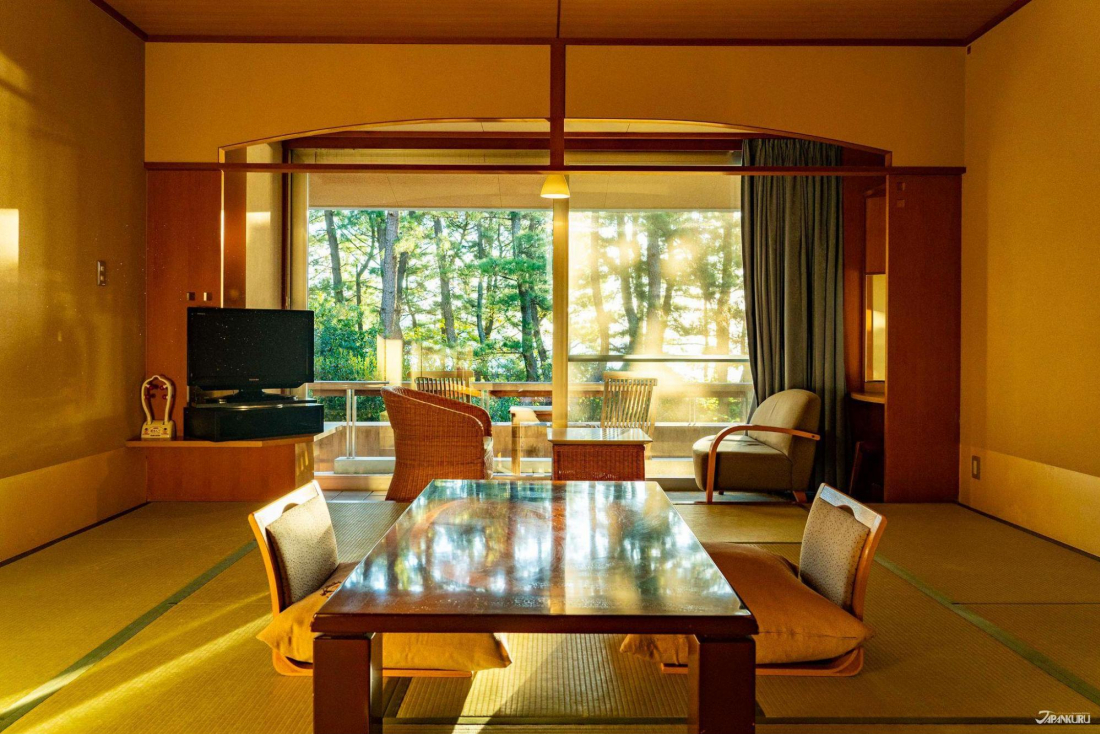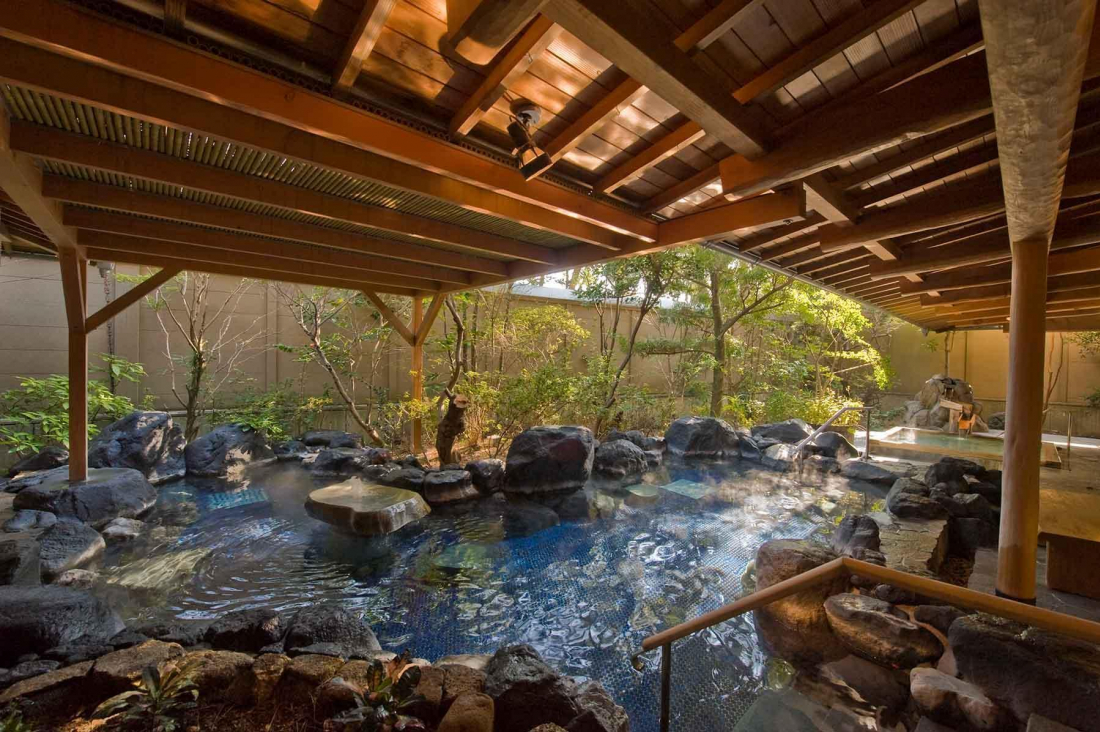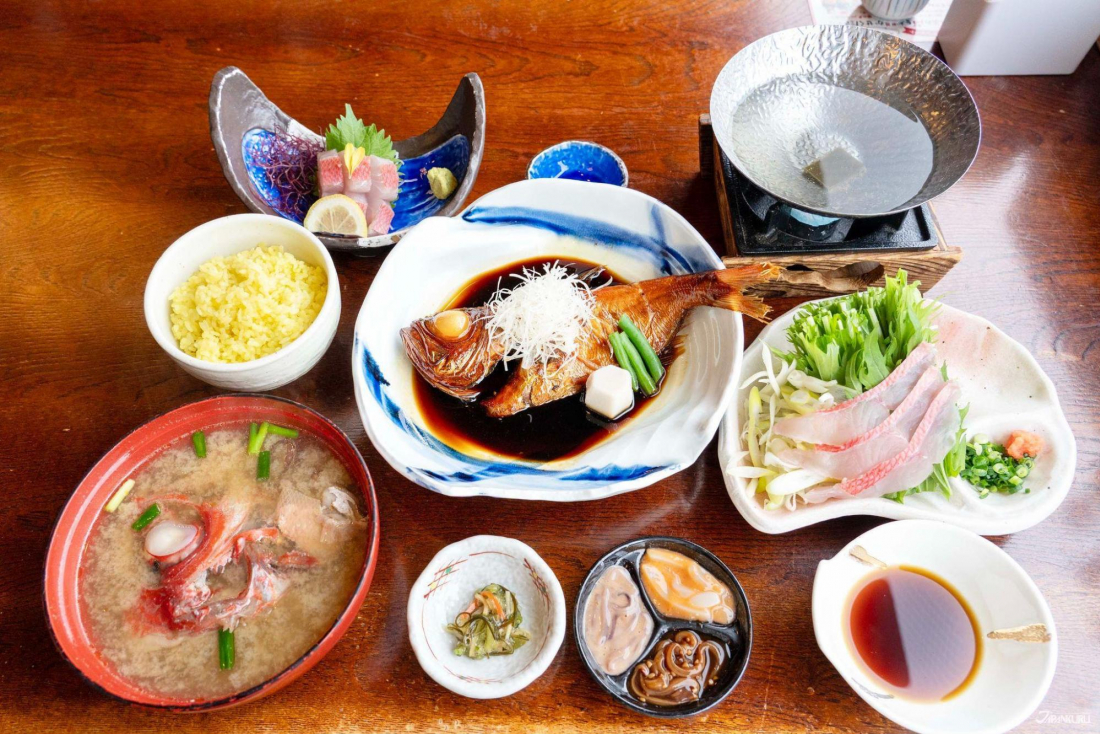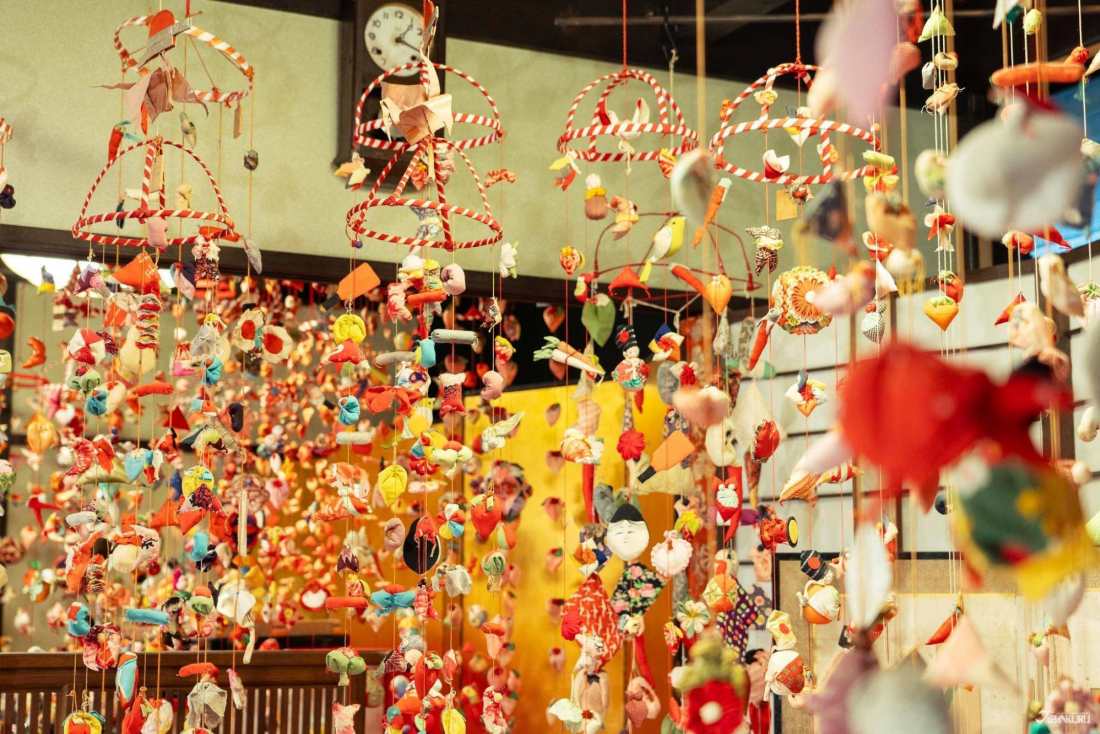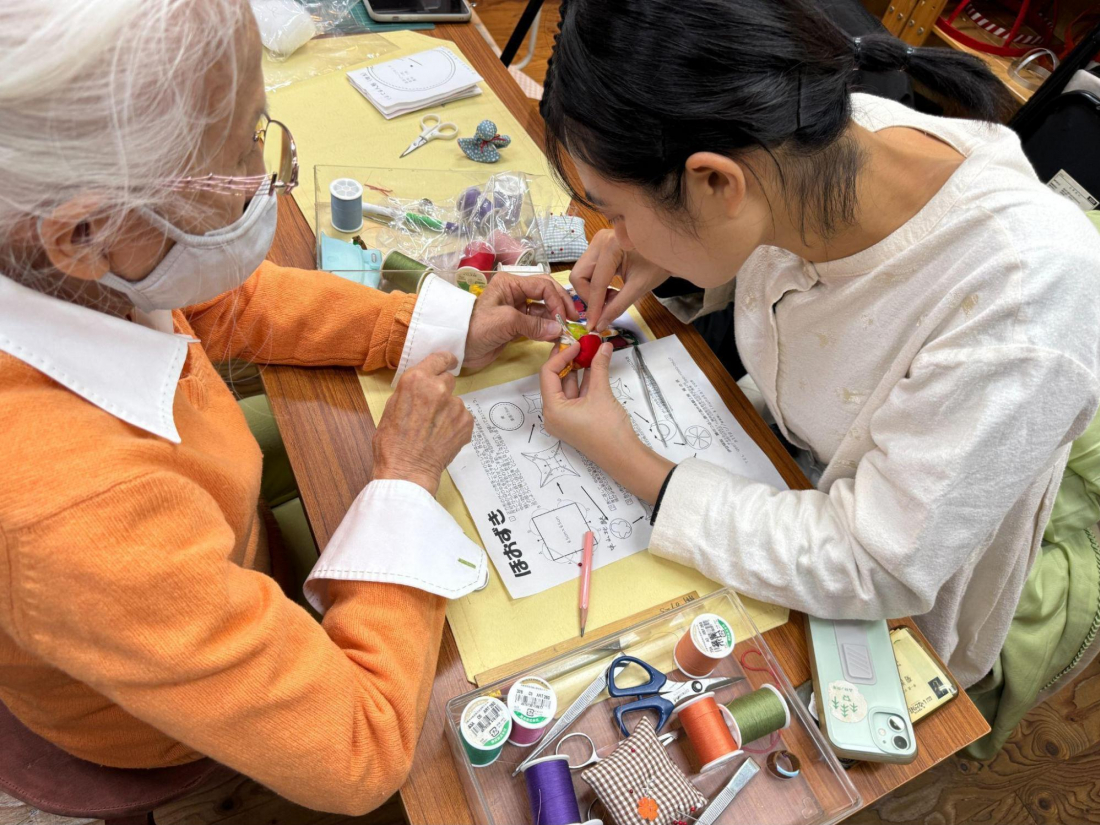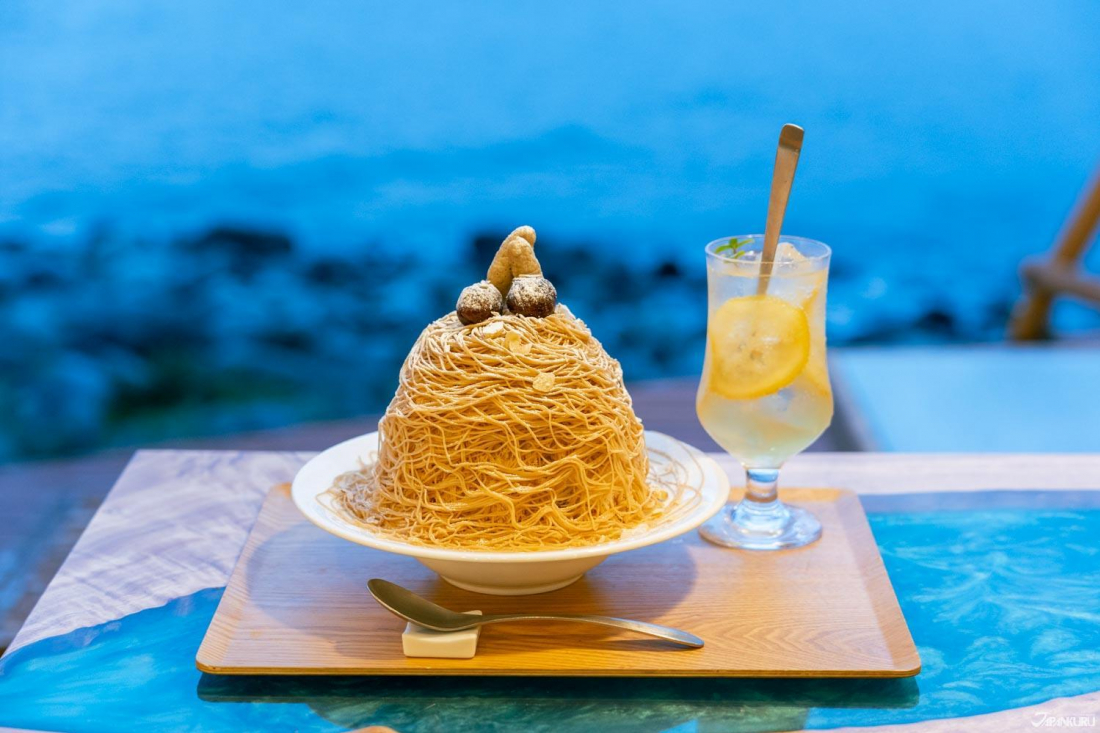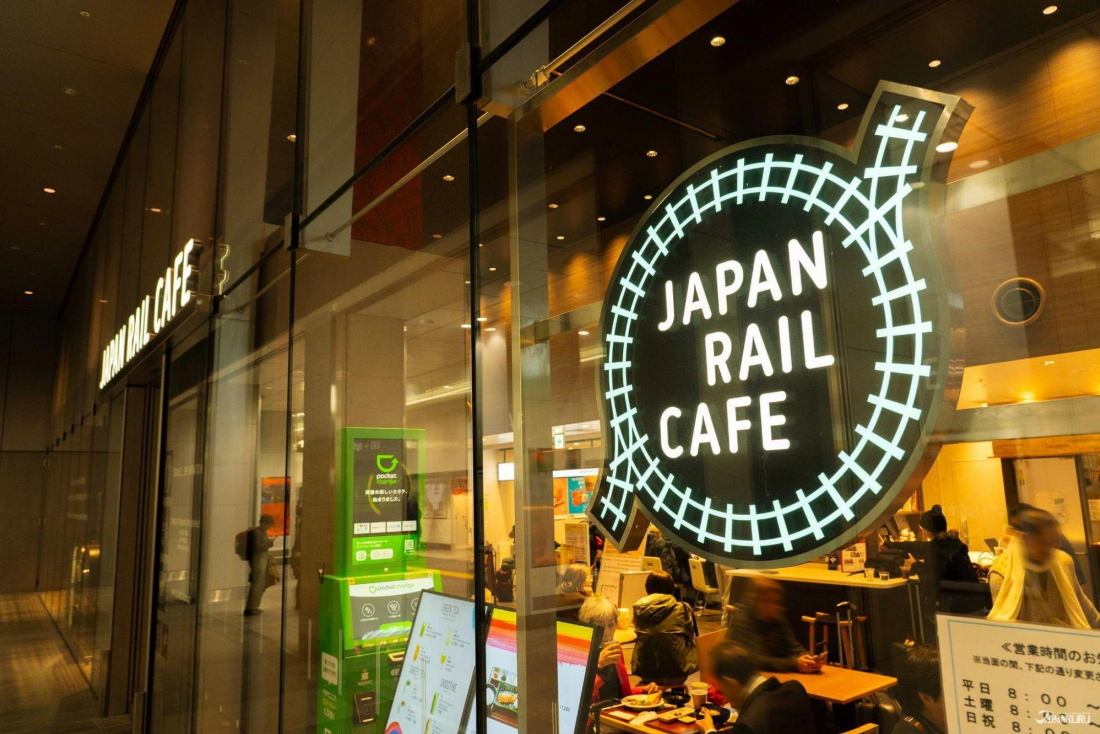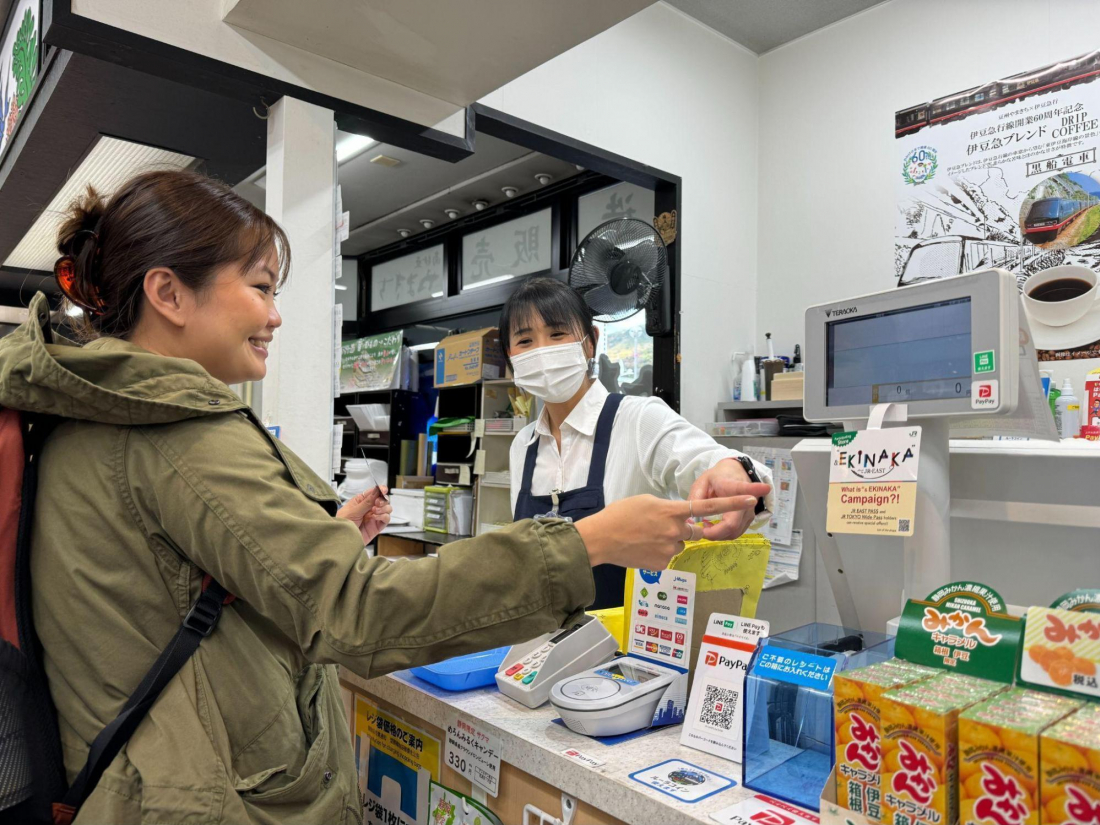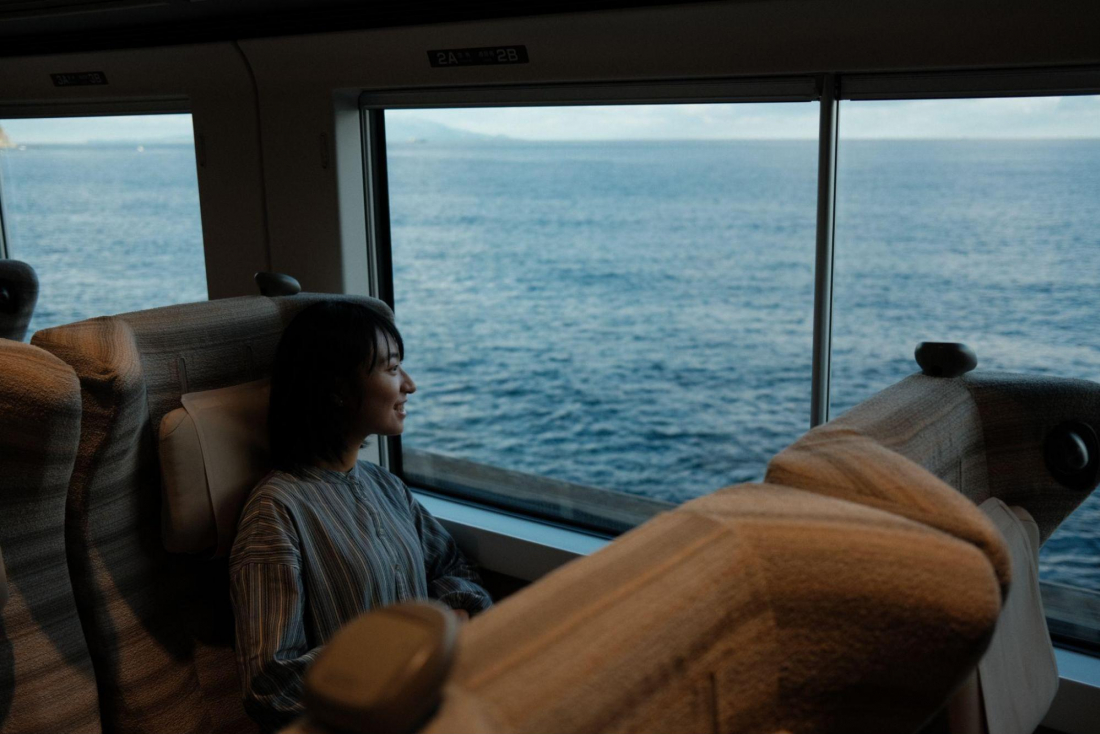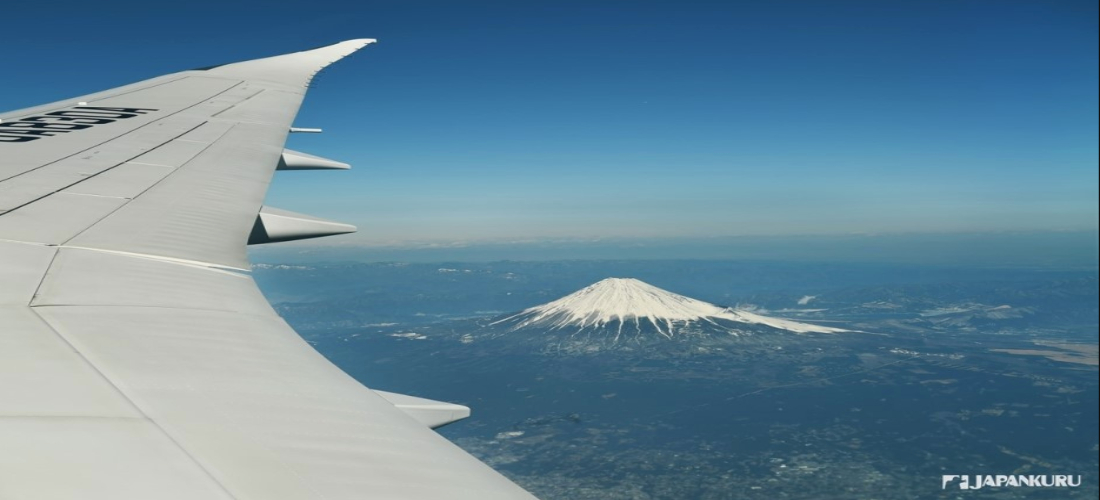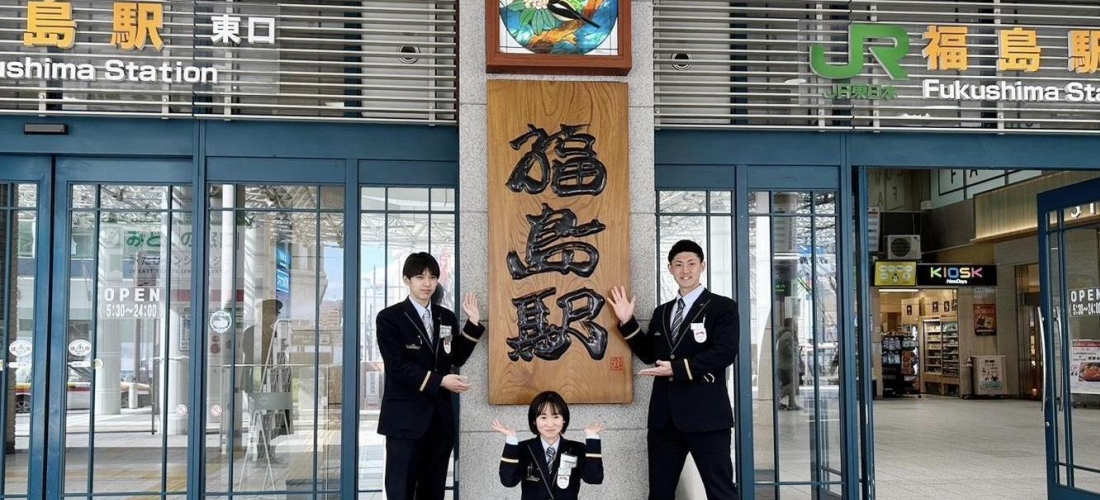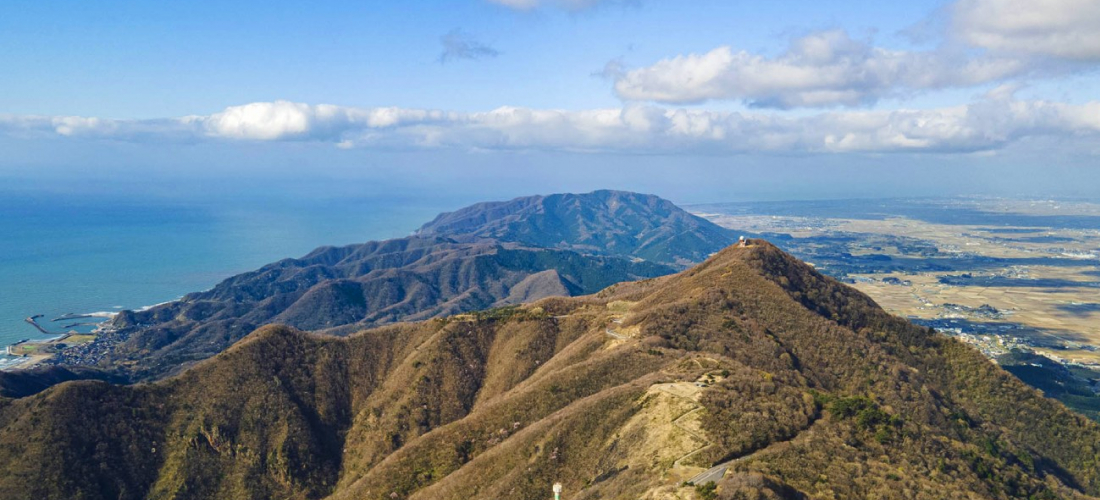
CONTENTS
The Izu Peninsula has long been a favorite for Japanese vacationers, thanks to the picturesque mountains, seashore, and hot springs. Each season brings new bursts of color to the scenery, with waves of Kawazu cherry blossoms, Atami plum blossoms, Shimoda hydrangeas, and wild narcissus flowers. Join us as we take the limited express Saphir Odoriko sightseeing train from Tokyo to Shimoda, on the southern tip of the Izu Peninsula.
South to Izu: From Flowers to Commodore Perry’s Black Ships
On this trip we'll be exploring the Shimoda area that sits on the very end of the Izu Peninsula, a spot that has made its way into history books as the very first port opened to the world on the main island of Japan after centuries of closed borders. The region is rich with history and monuments marking the past, but also bursting with new life that shapes the city's beautiful harbor and picturesque bay. In recent years the early summer hydrangea festival in Shimoda Park has become a favorite among flower lovers in Japan, and the nearby Kawazu Cherry Blossom Festival is famous for kicking off Japan's cherry blossom season by blooming bright and early each spring. During the same spring season, the Minami-Izu Cherry Tree and Canola Flower Festival offers yet more glorious fields of flowers to frolic in, along with rickshaw rides and sparkling lights after sunset. Located all the way at the end of a peninsula, thrust far into the reaches of the Pacific Ocean, Shimoda is also blessed with ample seafood (especially golden eye snapper, AKA kinmedai), along with luxurious onsen (hot springs) that draw visitors from all over Japan.
Formed from a series of submarine volcanoes, the Izu Peninsula is now a verdant green spit of land south of Tokyo, still dotted with the peaks and plateaus that remain from its volcanic days millions of years ago. The long coast is a mix of rocky cliffs and sandy beaches that many claim are the best in Japan, and as of 2018, the sumptuous scenery has earned the area the honor of becoming UNESCO's 9th global geopark in Japan, the "Izu Peninsula Geopark." For travelers exploring Japan, the region offers a mix of spectacular natural beauty, unique historical importance, traditional culture, and of course, great food!
Make the planning process easy for your next cherry blossom trip to Japan. Hop on the JR East sightseeing express Saphir Odoriko and come along on this trip to the end of the Izu Peninsula!
The Saphir Odoriko: Adding Extra Excitement to Train Travel
The Shimoda area of the Izu Peninsula, located in Shizuoka Prefecture, is located at a distance from Tokyo that isn't exactly near or far. If you take the ordinary train route, with a transfer at Atami, the trip takes about four hours. If you go for the JR limited express, however, the train goes directly from Tokyo to Shimoda in only about 2 hours and 43 minutes. To make the trip even more relaxing, JR East decided to launch the luxurious sightseeing train the Saphir, which comes equipped with special seats and interiors for a superior railway experience.
The Saphir offers three different seat options: standard seats in the Green Cars, deluxe seats in the Premium Green Cars, and private seats in the Green Car compartments. Even the standard seats on the Saphir offer the same level of added luxury as upgraded seats on the shinkansen, but the Saphir's compartments provide extra privacy and space to stretch out, and the premium seats in the front-most car are designed for a luxurious experience. The movable seats rotate to give passengers the same vantage point as the driver, including some breathtaking views of the coast and Mt. Fuji in the distance.
Many people choose the Saphir for the great views out the window and the comfortable convenience, but passengers shouldn't miss the train's dining car while aboard! The interior calls to mind the swanky dining cars of another era, with stylish retro furnishings and huge windows to gaze out at the scenery while you eat. Food offerings in the dining car range from full meals to lighter options and desserts, which are good for an afternoon snack or tea time. Some of the most recent additions to the menu include a series of recipes provided by Chinese restaurants from the Atami area of Izu, including noodle soup with shrimp wontons and Shanghai hairy crab cabbage rolls, each arriving at your table piping hot while the train zooms through the Japanese countryside. (For the dining car, advance reservations via Saphir Pay are recommended.) This train trip of over two hours always seems to pass by in a flash of comfortable seats, fresh flavors, and gorgeous scenery. Long before you reach your destination, it feels like to fun of a trip to Izu has already begun!
Shimoda Ropeway: Find Love and Views of Shimoda Port
Get off the train at Izukyu-Shimoda Station, and just about a minute away on foot you'll find the station for the Shimoda Ropeway, leading the way to one of Shimoda's most popular attractions. The ropeway makes its way up to the top of Mt. Nesugata, reaching a point about 200m above sea level, where you can look down at the city streets, Shimoda Port, and the blue waters that once welcomed the "black ships" that arrived from across the world to do trade with a newly opened Japan. The restaurant at the top of the mountain, "The Royal House Shimoda," is also a must-see for travelers visiting Shimoda. Diners can enjoy elegant drinks and desserts while relaxing in terrace seats overlooking the harbor below, or admiring the exquisite interior spaces.
The natural environment on Mt. Nesugata also provides a great place to enjoy Japan's four seasons, including early spring blooms of Kawazu cherry blossoms, early summer hydrangeas, and flowers like narcissuses or wild tri-colored peonies throughout the fall and winter. Locals say that the scenery is especially beautiful in early summer, making it one of Shimoda's most famous hydrangea spots, alongside the Hydrangea Festival in Shimoda Park.
Travelers looking for love can also visit the Aizen Myoodo, a little temple perched on the Nesugata mountainside enshrining a god of lust and desire. This octagonal hall honoring the Buddhist god Aizen-Myoo (AKA Ragaraja) was once located within the Shinto shrine of Kamakura Hachimangu, and was only moved to Shimoda after the Japanese government declared a policy of Buddhist and Shinto separation in the 19th century. Even in its new location, the temple attracts plenty of visitors, thanks in part to the cute crowd of Buddhist statues, and the frog statues that symbolize a century of marital bliss.
Shimoda Ropeway (下田ロープウェイ)
1-3-2 Higashihongo, Shimoda, Shizuoka
Hours:
10/16~3/15: 8:45 – 16:45
3/16~10/15: 8:45 – 17:00
*Ropeway may close temporarily in case of inclement weather. Please check the official homepage before arriving.
Access: 1 min on foot from Izukyu-Shimoda Station
Official Website (en)
Perry Road: A Meeting Point Between East and West, and a Step on the Path of History
The name "Perry Road" might not sound very Japanese, and that's because it's not, but Perry is certainly an important name in Japan's history books. For hundreds of years, Japan maintained an isolationist policy that forbade foreigners entrance to the islands, strictly avoiding trade and diplomacy with the West. But in the mid-19th-century, the US Navy sent Commodore Matthew C. Perry and 300 of his men to Japan in a fleet of "black ships" painted dark with pitch, on a mission to pry open the doors to Japan and start diplomatic relations, whether Japan wanted it or not. The mission ended in success for Commodore Perry, eventually resulting in the Treaty of Shimoda, which allowed US traders access to Shimoda's port, inevitably leading to Japan's arrival on the world stage.
Back in the 1800s, Shimoda's Perry Road was tread by the commodore and his crew as they marched to Ryosenji Temple, and modern-day visitors from abroad can retrace their path along the willow-lined road as it follows the route of the Namerikawa River. Perry Road is still paved with stone cobbles, and old buildings from the Meiji and Taisho eras (late 19th and early 20th centuries) remain standing along the way. Some shops still sell traditional crafts, while others have been reclaimed as coffee shops or specialty boutiques. The traditional atmosphere preserved along Perry Road is a little bit different from what you might find in Tokyo's more retro neighborhoods, with its own mix of Japanese and foreign influences, and it's a great area to explore on foot!
Perry Road (ペリーロード)
Sanchome, Shimoda, Shizuoka
Access: 14 min on foot from Izukyu-Shimoda Station
Official Page (jp)
Tsuchito Shoten Shop & Art Gallery: A Blast From the Past
Located just northeast of Perry Road, Tsuchito Shoten is a little store with a long history, founded all the way back in the Meiji period (1868-1912), and still providing customers with bottles of local sake and other regional specialties. The building is an old warehouse, with a retro logo painted along one outside wall that people love to take pictures in front of as a stop along Perry Road, and across the street there's a warehouse art gallery with free admittance. Visitors can not only take a peek inside an old Japanese warehouse, but also admire and take pictures with a whole collection of old signs, posters, cash registers, toys, and other bits of nostalgia collected by the shop over the years.
Tsuchito Shoten (土藤商店)
6-30 Sanchome, Shimoda, Shizuoka
Hours:
Shop: 9:00 – 20:00
Gallery: 9:00 – 18:00
Access: 12 min on foot from Izukyu-Shimoda Station
Official Website (jp)
Shimoda Snacks: ”Kaikoku” & Sea Salt Dorayaki
Just a quick seven-minute walk from Izukyu-Shimoda Station, Kineido is a local Japanese sweets shop that opened over a century ago in the 7th year of the Taisho period (1918), and is still beloved for its dorayaki. The shop has been in the Tsuchiya family for three generations, and the current owner attributes the shop's success to the great recipes and techniques inherited from his father. One of their most popular treats is their "Kaikoku" Shimoda Dorayaki, which refers to the "opening of Japan," referencing the role Shimoda played in Japan's history. Classic dorayaki are filled with red bean jam, but these Kaikoku Shimoda Dorayaki are made with added mandarin orange (grown locally) and fragrant bits of zest, for a little citrus kick. One of Kineido's other specialties is their dorayaki made with salted butter, which gives the red bean filling an extra layer of salty-sweet complexity.
If you love dorayaki, it can be hard to choose a favorite, so we recommend you try both! If the description of these tempting flavors isn't enough to convince you, then the kindness of the friendly owners (Mr. and Mrs. Tsuchiya) just might!
Kineido (金栄堂)
2-33 Takegahama, Shimoda, Shizuoka
Hours: 9:00 – 18:00 (closed for public holidays)
Access: 7 min on foot from Izukyu-Shimoda Station
Official Page (jp)
Tsumekizaki: A Sea of White Flowers by the Sea
The Izu Peninsula has been recognized by UNESCO as an official Global Geopark, and that includes the many unique patches of coastal terrain, and one of the most striking spots is called Tsumekizaki. Located in the southeast corner of Izu, Tsumekizaki's western coast includes a so-called "supernatural" rock formation referred to as the Tawaraiso, a mass of rock columns that look more like human-carved architecture than like a natural formation. But the unusual rocky outcropping isn't the only thing that makes the spot such a popular destination – Tsumekizaki also has an iconic white lighthouse surrounded by a whole swath of narcissus flowers that bloom each winter.
Take fun photos on the little path in front of the lighthouse, chosen as one of Japan's "100 Lighthouses to Fall in Love at," and make sure to check the route between the lighthouse and the seashore for more lovey-dovey photo spots along the way!
The seawater off the coast is bright and clear, with different shades of blue created by the shifting sands beneath the surf. On land, the grassy fields along the water provide space for some three million wild narcissuses (AKA daffodils) that bloom in December and January every year, creating a breathtaking landscape unique to Shimoda. Brilliant red aloe vera flowers and towering crimson camellia bushes also grow on both sides of the path at Tsumekizaki, and together with the white narcissuses, they create a sea of red and white each winter – Japanese New Year's colors!
Tsumekizaki (爪木崎)
Suzaki, Shimoda, Shizuoka
Access: from Izukyu-Shimoda Station, take the bus bound for Tsumekizaki from the #10 bus stop (15 min), get off at Tsumikizaki bus stop (the last stop)
Official Page (jp) | Narcissus Festival Official Page (jp)
Shirahama Shrine: White Sandy Beaches & Izu’s Oldest Shrine
The Izu Peninsula is a popular seaside destination for Japanese vacationers, but many travelers tend to flock to the beaches of Atami, on Izu's northern edge. What locals usually keep to themselves, however, is that there are quite a few beautiful beaches hidden along the southern end of the peninsula, too! One of those is Shirahama, literally "white beach," where Izu residents come every summer to enjoy the pristine sand and the clear seawater. But Shirahama isn't just a great place to play in the surf – it's also home to Izu's oldest shrine, commonly called Shirahama Shrine.
Officially named "Ikonahime no Mikoto Shrine," this shrine is said to have a history that stretches back some 2,400 years, and it has long been a destination for those seeking happiness in marriage. Couples arrive from all over Japan to pray for marital bliss, and some even hold their wedding at the shrine, including popular '70s singer Hideki Saijo. In more recent years, now that taking pretty pictures to post on social media has become a part of everyday life, the shrine's striking torii gate on the rocky coast has become a popular spot for photos as well.
Shirahama Shrine (白浜神社)
2740 Shirahama, Shimoda, Shizuoka
Access: from Izukyu-Shimoda Station, take the bus bound for Itado Ichiki (11 min), get off at Shirahama-jinja bus stop
Shimoda Snacks: Hot Spring Melon Monaka & More
If you're the kind of traveler who loves taking fun snapshots to share with your friends, then you won't want to miss these Shimoda "onsen melon" sweets from Ougiya. These little treats are made using sweet green melons grown locally using the gentle steam of Izu hot springs, with melon filling stuffed inside a cute melon-shaped Japanese "monaka" wafer shell. They make a crunchy version too, with an extra crispy shell!
Ougiya Confectionery runs a cafe and dessert shop where they not only sell their popular melon monaka, but also a variety of melon cakes and pastries only available in-store, like melon tarts, cream cakes, soda floats, and more. The cute pale green color of the melon makes everything look as good as it tastes!
Since these melons are cultivated using the help of the local onsen, they're grown all year round, which means that Ougiya can offer their fresh melon desserts throughout the seasons. The shop is a bit of a hike from Izukyu-Shimoda Station, but the trip can easily be made by bus in a little over 20 minutes. Fans of Japanese melons, or anyone with a serious sweet tooth, will find it a journey worth making.
Ougiya Confectionery (扇屋製菓)
168-1 Shimogamo, Minamiizu, Kamo District, Shizuoka
Hours: 9:00 – 17:00 (closed Wednesdays)
Access: from Izukyu-Shimoda Station, take the bus bound for Shimogamo from bus stop #3 (23 min), get off at Hizume bus stop (2 min on foot)
Official Website (jp)
Onsen Accommodations Recommendation: 5-Star Resort Toki Ichiyu
Since Izu is so well known in Japan for its hot springs, it would be a shame not to enjoy the luxuries of an onsen ryokan while visiting, and the 5-star Toki Ichiyu can be found right next to Minami-Izu's popular Yumigahama Beach. The traditional Japanese wood-frame building is bright and airy, with tatami-floored rooms looking out onto views of the sea filtered through a green pine forest.
As a hot spring hotel, Toki Ichiyu has large shared onsen baths along with a handful of private baths available for rental, and even a number of rooms with exclusive hot spring baths attached. The nice thing about the private baths at Toki Ichiyu is that they don't require any advance reservations or additional fees – guests are free to use whichever baths are open at the time.
Another ryokan treat is the food, which features seasonal recipes made with fresh local Izu seafood and vegetables. At Toki Ichiyu, the traditional kaiseki dinners include delicacies like kinmedai, grilled abalone, and seafood hotpot. In the morning, breakfast means another round of local kinmedai inside of grilled Japanese rice balls, plus spicy mentaiko pollock roe, and seared tuna.
Toki Ichiyu (季一遊)
902-1 Minato, Minamiizu, Kamo District, Shizuoka
Check-in/Check-out: 15:00~ / ~11:00
Access: from Izukyu-Shimoda Station, take a taxi (15 min), or reserve a hotel shuttle bus (20 min)
Official Website (jp)
Special: A Stopover in Izu’s Inatori
After exploring Shimoda on foot, head back to the train station and hop back on to get to Izu-Inatori, located just a stop away from Kawazu (famous for its early-blooming cherry blossoms). Join us in Inatori to eat more luxurious kinmedai, savor the sweetness of some surprisingly creative kakigori shaved ice, and feast your eyes on traditional Japanese crafts.
Tokuzomaru Fresh-Caught Seafood: Indulge in Kinmedai to Your Heart’s Content
As is clear from all the kinmedai (golden eye snapper) used in local cooking, this fish is a local specialty in Izu, and the Inatori area is especially famous for its delicious kinmedai cuisine. If you want to taste the fish at its best, you can't go wrong with Inatori. Right in front of the Inatori Fishing Harbor you'll find Tokuzomaru, a seafood restaurant that uses fresh-caught fish to prepare meals just the way the local fishermen like it. Options range from simple seafood rice bowls to more decadent multi-course kaiseki meals, and even kinmedai hitsumabushi, prepared Nagoya-style.
For foodies who want to thoroughly immerse themselves in the delicious umami of kinmedai, we recommend the Kinmedai Zukushi Set, which includes kinmedai grilled with soy sauce, served raw as sashimi, sliced thin for shabu-shabu hotpot, and cooked in miso soup, all in one meal. The set also comes with gardenia rice, an eastern Izu specialty! Before heading out, you can check out the souvenirs on the restaurant's first floor, too.
Tokuzomaru Inatori Fishing Harbor Shop (網元料理徳造丸 伊豆稲取漁港本店)
798 Inatori, Higashiizu, Kamo District, Shizuoka
Hours:
Weekdays: 9:30 – 16:45 (last order 16:00)
Weekends, Holidays, & Busy Season: 9:30 – 15:45 (last order 15:00) / 17:00 – 20:15 (last order 19:30)
Access: 10 min on foot from Izu-Inatori Station
Official Website (en)
Culture Park Hina-no-Yakata & Kinu-no-Kai: Traditional Crafts and Hina Matsuri Traditions
Not far from the fishing harbor, the Inatori Culture Park offers a look at a different kind of Inatori culture, with displays focused on the traditions surrounding Japan's Hina Matsuri, AKA Girl's Day. This Japanese holiday is for young girls, and celebrations often include displays of sumptuous dolls dressed in the opulent attire of ancient Japanese court dress. At Inatori's Hina-no-Yakata, they not only have exquisitely crafted dolls on display, but also hanging ornaments used for the festival. While wealthy families of the past could afford to buy the ornate Hina dolls, ordinary families have long relied on handmade hanging ornaments instead, similarly using them to represent well-wishes and hopes of health and happiness for the family's young women. Hanging Hina ornaments of this kind can now be seen in many parts of Japan, but Inatori is one of their earliest points of origin!
Inatori has strong cultural traditions surrounding Hina Matsuri, and that includes their "sky scraper Hina dolls," which are set on tall steps for a striking display that goes viral on the internet every year. Inatori's Hina-no-Yakata isn't always open all year round, so you'll want to check the official website before visiting, but if the timing is right during your next trip to Inatori, this spot is a must-see!
Culture Park Hina-no-Yakata (文化公演 雛の館)
1729 Inatori, Higashiizu, Kamo District, Shizuoka
Hours: 9:00 – 16:00 (final entrance 15:40)
Access: 15 min on foot from Izu-Inatori Station
Official Website (jp)
After admiring all the cute ornaments on display at Inatori Culture Park, you can actually try making one yourself! Not far from the Hina-no-Yakata, the Kinu-no-Kai Workshop offers handicraft workshops led by "local moms," who help you hand sew your own hanging decorations. Workshops are divided into beginner, intermediate, and advanced levels, and price/time requirements depend on which ornaments you want to make. On this trip to Izu, we tried making Chinese lantern berry ornaments (beginner level), which are said to be a symbol of good health. Although the local moms who teach the workshops mostly speak Japanese, they also provide illustrated instructions for each ornament, so it's not hard to understand the process. Make a reservation on the Kinu-no-Kai website to try the workshop yourself!
Kinu-no-Kai (絹の会)
429 Inatori, Higashiizu, Kamo District, Shizuoka
Hours: 9:30 – 18:00 (closed Tuesdays)
Official Website (jp)
Kitchen Zen Food & Kakigori: Seasonal Shaved Ice to Match the Scenery
Kitchen Zen is one of Inatori's most popular seaside cafes, and while their lunch sets always draw a crowd at midday, the shop is best known for its kakigori shaved ice made with seasonal Izu ingredients. For autumn, the shop was offering "Izu Chestnut Mont Blanc Kakigori," which screams autumn with just its bold appearance alone. Take a taste, and this shaved ice might just subvert all your expectations, with the sweet scent of chestnut mixing into the mellow flavor of black tea ice, and little pops of hazelnut and berry flavor. The owner, previously a chef at a restaurant specializing in Japanese cuisine, uses expertise with seasonal ingredients to create innovative shaved ice options bursting with flavor, all throughout the year. The cozy shop with its fantastic ocean views should be added to any foodie's itinerary.
Kitchen Zen: お食事&かき氷キッチンZEN)
3-13 Inatori, Higashiizu, Kamo District, Shizuoka
Hours: 11:30 – 14:30 (last order 14:00) / 18:00 – 21:30 (last order 21:00) (closed Wednesdays & Thursdays)
Access: 10 min on foot, north along the shore, from Izu-Inatori Station
Official Instagram
Transportation Advice
While we recommend taking the JR limited express Saphir Odoriko from Tokyo to save time and maximize comfort on your way to Shimoda, for a great deal on travel costs, the best method is to use the JR TOKYO Wide Pass from the JR EAST Group, made specifically for foreign travelers in Japan. The JR TOKYO Wide Pass is available for 15,000 yen per adult, and offers unlimited rides on designated Tokyo area train lines for three whole days, including shinkansen and limited express trains from JR EAST and other railways. You can use it to explore Izu using the Izukyu Line, too! (The limited express sightseeing train Saphir Odoriko requires an additional seat fee.) And since the JR TOKYO Wide Pass can also be used to travel from Izu to areas like Karuizawa, Kawaguchiko, and GALA Yuzawa, you can plan a train trip to some of Japan's most popular spots for a great price.
Plus, it's easier than ever to buy a JR TOKYO Wide Pass, now that you can scan your passport and buy the pass directly from a ticket machine without needing to go to a ticket window. You can also make reservations online, while you're in Japan or before you even arrive, to book seats for Rail Pass trips or the limited express Saphir Odoriko using the JR-East Train Reservation page.
The passes aren't just available at ticket machines, though. Visit the Japan Rail Cafe at Tokyo Station for tickets and advice on your trip from multilingual staff, plus a full cafe menu. It's a great place to pass the time while you wait for your train!
The great deals don't just stop at the train tickets themselves, either. JR EAST is currently offering a special promotion for foreign tourists called "&EKINAKA," which means that customers using a JR TOKYO Wide Pass, JR EAST PASS (Nagano, Niigata area), or JR EAST PASS (Tohoku area) also get discounts at a variety of shops in and around train stations. For example, travelers visiting Izukyu-Shimoda Station can shop for souvenirs at Zushu Yamakichi and show their JR EAST pass at checkout for a special discount.
All Aboard for a Tour of Shimoda, Izu
A limited express trip from Tokyo to Izu's city of Shimoda might be just the right distance for railway lovers, aboard a normal JR limited express train or the stylishly luxurious Saphir Odoriko, with the two-and-a-half hour journey providing just enough time to enjoy the scenic views of Japan's countryside, and maybe a bite to eat. After settling into your trip on the train, just keep the momentum going in southern Izu with views of Shimoda's cozy harbor, glimpses of pink cherry blossoms or golden canola flowers, and delicious morsels both sweet and savory in Inatori, to make the most of your time in Izu!
Details
NAME:JR EAST
PROFILE
Follow us @Japankuru on Facebook, Instagram, and Twitter!
COMMENT
FEATURED MEDIA
VIEW MORE
・Accommodations for Odaiba Sightseers: Mitsui Garden Hotel Toyosu PREMIER ・住宿推薦 三井花園飯店 豐洲普米爾 ・오다이바 관광 맞춤 숙소: 미츠이 가든 호텔 토요스 프리미어 ・ค้างคืนที่ Mitsui Garden Hotel Toyosu Premier โรงแรมสำหรับผู้มาเยือน Odaiba #japankuru #odaiba #tokyo #tokyotrip #japantrip #japantravel #mitsuigardenhotel #mitsuigardenhoteltoyosupremier #tokyohotel #odaibahotel #toyosu #tokyoview #tokyobay #rainbowbridge #미츠이가든호텔토요스프리미어 #오다이바 #오다이바맛집 #오다이바건담 #오다이바해변공원 #오다이바야경 #오다이바온천

Nagano Prefecture is famous for delicious soba noodles, and in the city of Ueda, you can learn from the experts! Local aunties run this cooking class, teaching you everything you need to know to make your own delicious plate of soba noodles entirely from scratch. #japankuru #soba #sobanoodles #japanesefood #travelexperience #japan #japantrip #ueda #nagano #japaneseculture #japanexperience #daytrip #daytour #cookingclass #japanesecookingclass #上田市 #そば作り #소바체험 #우에다시 #나가노여행 #일본소바

Kuramae Shrine is known for its early-blooming cherry blossoms and its gorgeous golden mimosa blooms, making it a great sakura spot for travelers arriving in Tokyo a little early for the main cherry blossom season. It’s also tucked away in a neighborhood packed with trendy cafes and coffee shops. Kuramae is a lovely place to spend the day. 🌸☕️ ・ #japankuru #kuramaeshrine #kuramae #tokyo #tokyotrip #cherryblossom #cherryblossoms #mimosa #tokyocherry #花見 #蔵前神社 #ミモザ #桜 #東京 #Japan #日本 #일본 #Japon #ญี่ปุ่น #Japão #Japón #япония #japantravel #日本旅行 #日本旅遊 #일본여행 #japan_of_insta #japantrip #traveljapan

Local Japanese Favorites at the Okinawa Don Quijote ② Ohta’s Isan, the digestive aid of the Japanese people ・ ・ 2024唐吉訶德不可不知的好物推薦② 日本國民消化小幫手:太田胃散 ・ ・ 오키나와 돈키호테 숨은 꿀템2. 일본 국민 소화제! 오타이산 #japankuru #okinawa #donki #沖縄 #오키나와 #오키나와여행 #오키나와돈키호테 #일본쇼핑리스트 #오타이산 #일본소화제 #太田胃酸 #ohtasisan

Happy Valentine's Day from the Japankuru team! May your day be full of sweet chocolates and sweet nothings. 💕 Or, if you're like a rising number of women in Japan, take the opportunity to treat yourself! 🍫💝💆 • Find out more at Japankuru.com! (Link in bio.) • #japankuru #valentinesday #valentineschocolate #japanesechocolate #japaneseculture #バレンタイン #バレンタインチョコ #メリーチョコレート #Japan #日本 #일본 #Japon #ญี่ปุ่น #Japão #япония #japantravel #日本旅行 #日本旅遊 #일본여행 #japan_of_insta #japantrip #traveljapan #japan🇯🇵 #japanlife #igerstokyo #explorejapan #japanfocus #enjoyjapan #japantravelphoto

Japankuru Coupon: BEAMS fashion, accessories, lifestyle goods, and more! BEAMS 5% Discount Coupon ▶︎ Validity Dates: February 1 ~ February 29, 2024 ▶︎ Discount: 5% off all products in-store ▶︎ Usable At: BEAMS stores throughout Japan (all stores except BEAMS JAPAN Izumo and BEAMS JAPAN Nikko) ▶︎ Details: Please present this coupon page before payment to receive your discount! This coupon is also valid in combination with tax-free discounts/refunds for foreign tourists. (Tax-free shopping is only available at some BEAMS locations.) Some products may not be eligible for discount. ・ ・ ・ BEAMS - JAPANKURU優惠折扣券 BEAMS 2024年2月限定特別優惠券 店內全部商品95折 ▶︎使用期間:2024/2/1到2024/2/29 ▶︎使用範圍:日本全國店舖 ▶︎使用方法:結帳時請務必事先向店員出示本優惠券,若未出示本優惠券恕無法享有本優惠。本優惠券可搭配免稅優惠一併使用,但不排除特定門市無法使用本優惠券。此外,不排除特定商品不適用本優惠券。 ・ ・ ・ 「빔즈(BEAMS) x 재팬쿠루(JAPANKURU)」스페셜 할인 쿠폰 빔즈(BEAMS) 5% 할인 쿠폰 ▶유효기간: 2024년 2월 1일 ~ 2월 29일(한 달 동안) ▶︎할인율: 매장 내 전 상품 “5% 할인" ▶︎해당 매장: 일본 전국 빔즈 (BEAMS) 매장 (BEAMS JAPAN이즈모、BEAMS JAPAN닛코는 쿠폰 할인 대상 제외 점포입니다) ▶︎상세 내용: 결제 전 본 쿠폰 페이지를 제시하면 정가대비 5% 할인된 금액에 구매하실 수 있습니다! 본 쿠폰은 외국인 관광객들을 대상으로 하고 있으므로 면세 혜택(빔즈 일부 매장)과 별도로 추가 할인이 가능합니다. (일부 매장 및 제품은 대상에서 제외될 수 있습니다.) #japankuru #beams #beamsjapan #beamsginza #coupon #재팬쿠루 #빔즈재팬 #빔즈 #일본여행 #일본쇼핑 #일본쇼핑리스트 #銀座 #東京 #tokyoshopping #japankurucoupon

